Cavatelli is a celebrated Italian pasta that has delighted food lovers for centuries. Its name translates to “little hollows,” reflecting the small grooves that make it perfect for holding sauces and toppings. This handmade pasta, originating from southern Italy, is a culinary treasure that continues to captivate chefs and home cooks worldwide.

The Origins of Cavatelli
Cavatelli hails from the regions of Abruzzo, Molise, and Apulia, where it has been a staple for generations. Each region has its unique twist, from its preparation methods to the types of sauces it’s paired with. Cavatelli’s simplicity—made with just semolina flour and water—has made it a versatile dish that adapts to various culinary traditions.
The dough’s texture is key to the success of cavatelli. Incorporating alternative flours like corn flour (Corn Flour: A Versatile Kitchen Staple) can offer unique flavors and textures for those looking to experiment beyond the traditional recipe.
How to Make Cavatelli
Making cavatelli is a rewarding process. Unlike more complex pasta shapes, this pasta is shaped by hand, making it accessible to cooks of all skill levels.
Ingredients
- 2 cups semolina flour
- ¾ cup warm water
- Optional: A pinch of salt
Method
- Combine semolina flour and water to form a pliable dough. Knead for about 10 minutes.
- Let the dough rest for 30 minutes.
- Roll the dough into long ropes, cut into 1-inch pieces, and press each piece with your finger to form a hollow.
- Cook in salted water until the cavatelli floats to the top, usually 3–5 minutes.
Pairing Cavatelli with Sauces and Ingredients
The grooves in cavatelli make it perfect for capturing flavorful sauces. It is traditionally paired with hearty vegetable-based sauces like broccoli rabe or spinach and cream. For a twist, consider using spinach and cream-based sauces (Knorr Spinach Dip Recipe: A Timeless Classic).
Popular Pairings
- Broccoli Rabe and Garlic: A classic combination that balances bitterness and savoriness.
- Tomato and Ricotta: A creamy and tangy option for vegetarians.
- Seafood: Pair with clams or mussels for a coastal-inspired dish.
For a gourmet touch, consider garnishing with pistachios as a topping for cavatelli (The Ultimate Guide to Pistachios: Nutrition, Benefits, and Uses). The nutty crunch pairs beautifully with creamy sauces or roasted vegetables.

Cultural Significance of Cavatelli
In Italy, cavatelli is more than just pasta; it is a symbol of heritage and tradition. It often features in festive meals and family gatherings, particularly in southern Italian households. Regional festivals dedicated to pasta showcase cavatelli’s enduring popularity.
Frequently Asked Questions
What is the difference between cavatelli and gnocchi?
While both are small and hand-shaped, cavatelli is made from flour and water, while gnocchi often includes potatoes.
Can I freeze cavatelli dough?
Yes! Wrap the dough in plastic wrap and store it in the freezer for up to three months.
What is the best way to serve cavatelli?
Cavatelli is versatile and can be served with light vegetable sauces, rich meat sauces, or even simply tossed with olive oil and garlic.
Nutritional Benefits of Cavatelli
Cavatelli made with semolina flour is a nutritious choice for pasta lovers. Its high protein and fiber content make it a healthier option compared to refined white flour pasta.
- Calories: Approximately 200 per cup (uncooked)
- Protein: 7 grams
- Fiber: 2 grams
Adding nutrient-rich ingredients like vegetables or lean proteins enhances the health benefits of a cavatelli-based meal.
Modern Takes on Cavatelli
Contemporary chefs are reimagining cavatelli by incorporating non-traditional ingredients such as beet or spinach puree into the dough, giving it vibrant colors and flavors. Experimenting with alternative sauces and toppings has also brought cavatelli to the forefront of modern Italian cuisine.
Conclusion
Cavatelli is a timeless classic that bridges tradition and innovation. Its simple ingredients, versatile pairings, and cultural significance make it a dish worth exploring. Whether you’re enjoying it with a hearty broccoli rabe sauce or experimenting with new flavors like pistachio garnishes, cavatelli offers endless possibilities for creativity in the kitchen.
By incorporating links to relevant resources like corn flour alternatives, spinach-based sauces, and pistachio garnishes, you can create a well-rounded and flavorful journey into the world of cavatelli. Try making it at home to experience the art of Italian cooking firsthand!
